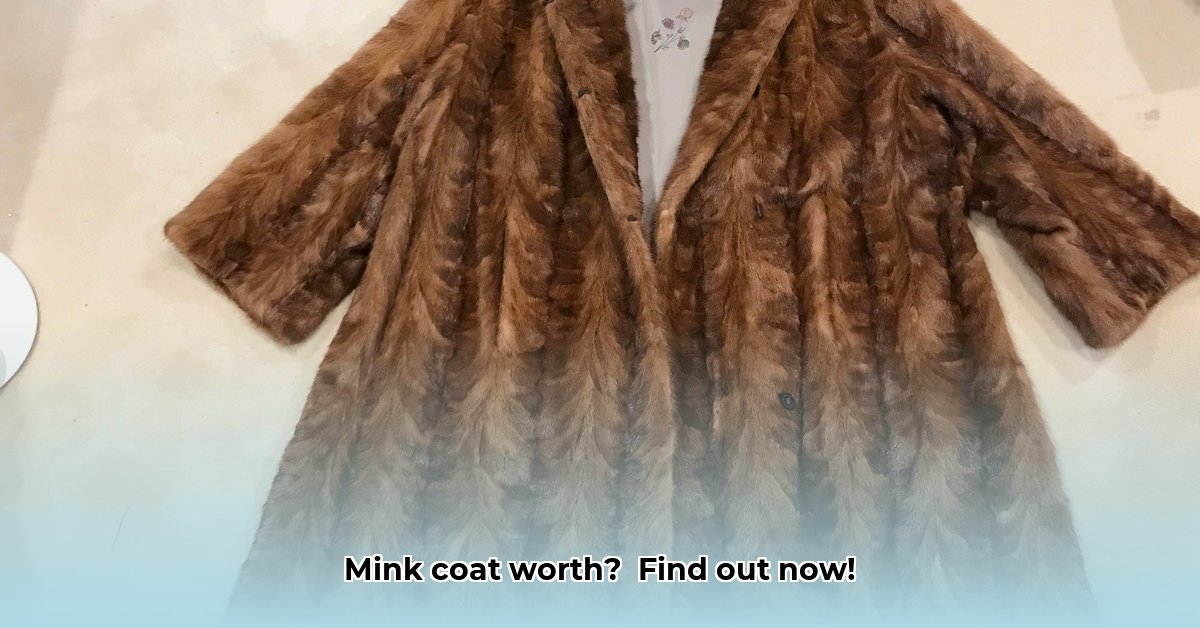
Determining the value of a vintage mink fur coat requires a nuanced understanding of several factors, from the type of mink and its condition to the designer and current market trends. This guide provides a step-by-step approach to assessing your coat's worth and ethically selling it for the best possible price.
Factors Affecting Your Coat's Value
Numerous elements contribute to a mink coat's value. Think of it like a complex equation: each variable influences the final outcome. Let’s break down the key factors:
Fur Type and Condition: The type of mink (e.g., Saga, Blackglama) significantly impacts value. High-quality, sought-after types command premium prices. Moreover, a coat's condition is paramount. A lustrous, undamaged coat is worth considerably more than one with matting, fading, or damage. Even minor imperfections can lower the value. Does your coat reveal a rich, consistent color and texture, or does it present imperfections?
Designer and Brand Recognition: A coat from a prestigious designer like Chanel or a renowned furrier will fetch a higher price than an unknown brand. This brand recognition enhances its potential resale value. Does your coat bear a coveted designer label, bolstering its appeal to discerning buyers?
Vintage and Style: Certain eras are more coveted than others. Mid-century coats, for example, are often highly collectible. The coat's style also matters; those with enduring appeal retain more value. Is your coat's style considered timeless or does it reflect a particular era which might enhance collectability?
Size and Versatility: Popular sizes and styles that remain fashionable command higher prices. Coats in less common sizes can have a smaller pool of potential buyers. Does your coat's size and style align with current fashion preferences, broadening its market appeal?
Authenticating Your Mink Coat: Ensuring Genuineness
Before selling, confirming authenticity is crucial. This not only ensures you get a fair price but also ensures responsible reselling practices.
Steps to Verify Authenticity:
Visual Inspection: Carefully examine the fur for inconsistencies in color or texture. Genuine mink fur typically exhibits consistent texture and coloring, whereas faux fur may show inconsistencies. Also, examine the stitching; genuine mink coats usually have impeccable stitching.
Burn Test (Use with Extreme Caution): As a last resort, and only on a hidden, inconspicuous area, carefully burn a tiny fiber. Real mink smells like burning hair; synthetic materials will smell like burning plastic and often melt. This method is destructive and should be used sparingly.
Leather Examination: Check the leather lining and details. Genuine leather will have a natural texture, possibly with subtle imperfections, while synthetic leather feels uniformly smooth and plastic-like.
Professional Appraisal: For valuable coats, seek expert appraisal from a reputable furrier or auction house. This provides documented evidence of authenticity and condition, beneficial for selling.
Selling Strategies: Maximizing Your Return
With authentication confirmed, consider these options:
Online Marketplaces (eBay, Etsy): These platforms offer wide reach, but require high-quality photos and meticulously detailed descriptions highlighting the features discussed above.
Consignment Shops: Luxury consignment shops specializing in vintage goods handle sales, but take a commission. This approach simplifies the process but reduces your overall sale price.
Auction Houses: This route is suitable for exceptionally rare or valuable coats and often attracts more serious buyers willing to pay a premium. However, auction fees might apply.
Direct Sales: Selling privately to friends, family, or other contacts eliminates commissions but requires more marketing effort.
Ethical Considerations: Responsible Reselling
The ethical implications of fur are evolving. Transparency about your coat's origin is increasingly valuable to ethical buyers. Consider these points: * Transparency: Be upfront about the coat's history and sourcing. * Donation: If you're uncomfortable reselling, consider donating the coat to a charity. This ensures responsible disposal and supports a worthy cause.
Price Ranges: A General Guide
Pricing varies substantially. Several factors, including all the aspects previously discussed, influence the final price. These values are estimates and should not be treated as accurate pricing. Accurate valuation requires professional appraisal.
Approximate Price Ranges (USD): (These are broad estimates only. Actual prices will vary considerably.)
| Condition | Designer/Brand | Estimated Price Range (USD) |
|---|---|---|
| Poor | Unknown | $100 - $500 |
| Fair | Unknown | $500 - $1,500 |
| Good | Mid-range | $1,500 - $5,000 |
| Excellent | High-end | $5,000 - $20,000+ |
| Exceptional | High-end, Rare | $20,000+ |
Maximizing Resale Value: A Step-by-Step Guide
To maximize your coat's resale value, follow these steps:
- Accurate Valuation: Professionally appraise the coat for a realistic price.
- Thorough Preparation: Clean and repair the coat professionally.
- High-Quality Photos: Showcase the coat's condition with high-resolution images.
- Detailed Description: Provide a comprehensive description, highlighting its key attributes.
- Strategic Platform Choice: Choose the selling platform that best suits your coat and target audience.
- Ethical Considerations: Be transparent about the coat's origin and consider ethical alternatives like donation.
By following this guide, you can effectively assess your mink coat's worth, navigate the ethical considerations surrounding secondhand fur, and achieve a successful and responsible sale.